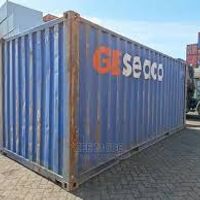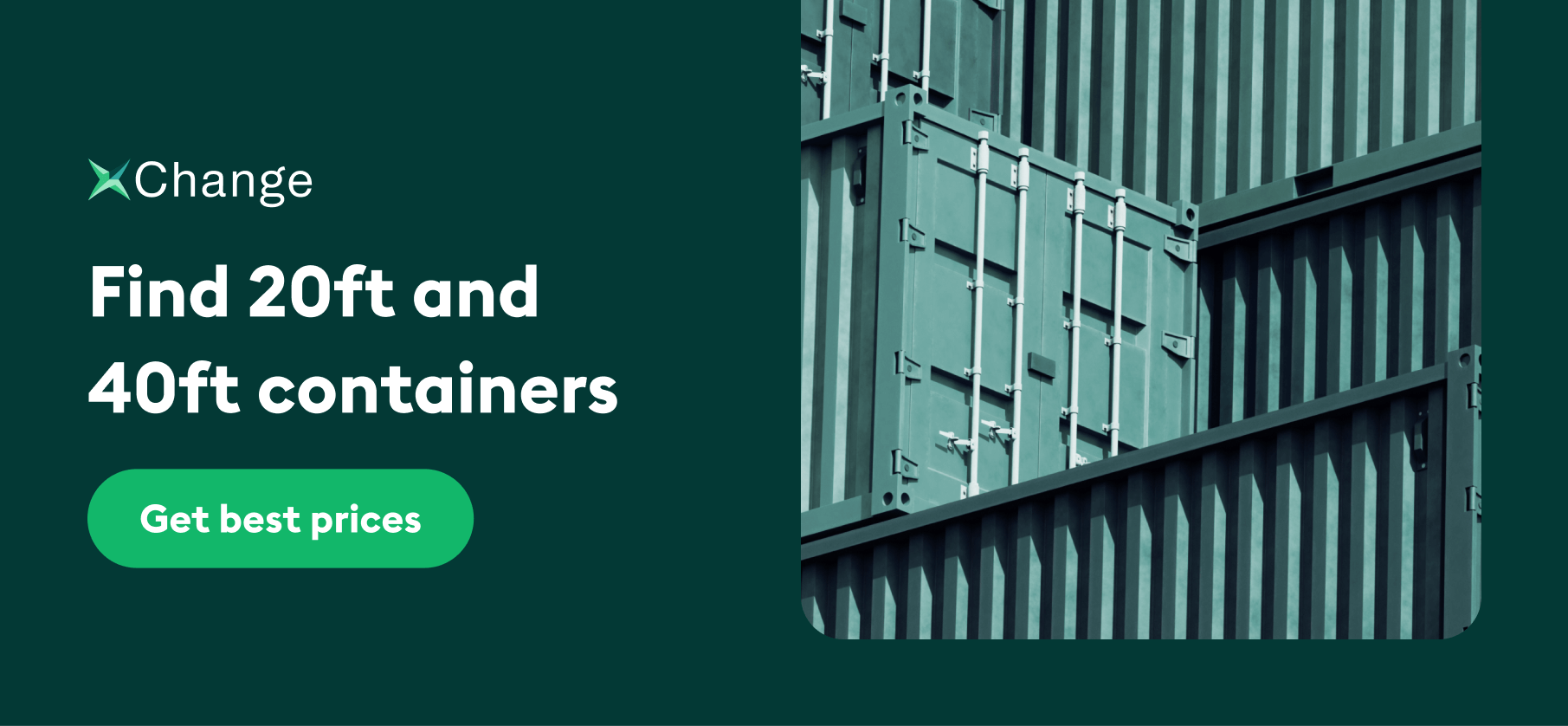Debating between a 20ft and 40ft container for your shipments? This blog will help you choose the right size for your cargo. Plus, learn how to source the containers you need at a price that fits your budget in just a few easy steps.
When transporting cargo, choosing the right container makes all the difference. The two most popular choices for moving dry goods are 20ft and 40ft containers.
Read on to understand the dimensions, capacity, and cost of each container size in detail. This will help you make an informed choice for your shipments and your budget.
For seasoned professionals looking to find the best deals, you’re in the right place too. Container xChange, the largest global container marketplace, has over 100,000 containers in 2,500+ locations worldwide.
Use our public search below to explore unbeatable container offers in your preferred locations today.
10,321 results found on the platform.
Container prices start from $350/unit.
Currently no match for your search
Change your search criteria or fill out the form below to get notified via email when there is a new match for you on xChange!
-
Pick-up
20DC (Cargo worthy)
37 units available
YOM:
Year of manufacture:
2004
2010
Savannah, GA
per container
Non-negotiable price$
925
-
Pick-up
40HC (Cargo worthy)
4 units available
YOM:
Year of manufacture:
2004
2010
Los Angeles, CA
per container
Non-negotiable price$
1650
-
Pick-up
40HC (Cargo worthy)
7 units available
YOM:
Year of manufacture:
2004
2010
Chicago, IL
per container
Non-negotiable price$
1700
Showing 3 of 10,321 results
Load more()
YOM:
Year of manufacture:
per container
$
20ft and 40ft container dimension comparison
A standard 20ft shipping container is 5.9m (length) x 2.35m (width) x 2.39m (height), and a 40ft is 12.03m (length) x 2.4m (width) x 2.39m (height).
In the below table, you can compare the dimensions of the 20ft and 40ft side by side:
| Dimensions of 20ft and 40ft shipping containers | ||
| 20ft container | 40ft container | |
| Length | 19.3 ft/5.9 m | 39.4 ft/12.03 m |
| Width | 7.7 ft/2.3 m | 7.8 ft/2.4 m |
| Height | 7.8 ft/2.3 m | 7.8 ft/2.3 m |
Next, we’ll look at the weight and payload capacity of these two container sizes.
Container weights and payload capacity comparison
The capacity of a container determines how much cargo it can hold, both in terms of volume and shipping container weight.
Now, let’s compare the 20ft vs 40ft in terms of container weight and payload for better understanding.
| Weight & Capacity of 20ft and 40ft shipping containers | ||
| 20ft container | 40ft container | |
| Tare weight | 5,071 lbs/2,300 kg | 8,268 lbs/3,750 kg |
| Payload capacity | 55,126 lbs/25,000 kg | 61,200 lbs/27,600 kg |
| Cubic capacity | 1,172 cu ft/33.2 m³ | 2,389 cu ft/67.7 m³ |
Despite the size, 20ft container is better suited for heavier cargo due its lighter structure. Please note that the extra weight of a 40ft container can lead to higher transport costs.
If neither of these sizes suits your cargo requirements, don’t worry. You can always opt for the 40ft high cube shipping container. The 40ft high cube containers have the same dimensions as their 40ft counterpart but with an extra foot of height.
If you’re ready to buy a 20ft or 40ft container for your next shipment, you can browse and compare container offers on the xChange marketplace right now. Choose from 100,000+ units available from vetted suppliers. Click the banner below to learn more.
Shipping container cost comparison
Let’s take a look at the average shipping container cost for these two container sizes below.
| Shipping container cost comparison of 20ft and 40ft shipping containers | ||
| Container type | Used | New |
| 20ft container | $1,500 and $3,000 | $2,500 and $5,000 |
| 40ft container | $2,000 to $4,500 | $3,500 to $6,500 |
Generally speaking, the 40 ft container is only around 30% more expensive than the 20ft—for almost double the capacity!
When it comes to the cost of shipping, a 20ft container is cheaper to ship due to its lighter weight and smaller size. However, the cost per cubic meter for shipping a 40ft container is lower, making it more economical for bulk cargo.
Best use cases: When to use 20ft vs 40ft shipping container?
Choosing the right container size largely depends on your specific requirements, including the type of cargo, budget, and operational constraints.
When to use a 20ft container:
The 20ft container is best for shipments where weight matters more than size. Its compact size and lower cost make it an excellent choice in the following situations:
- Small shipments: Ideal for dense and heavy goods such as steel coils, machinery, or building materials.
- Limited space: Works well in locations with restricted loading or storage areas.
- Heavy cargo efficiency: The high payload capacity of a 20ft container allows it to carry heavier cargo more economically.
When to use a 40ft container:
The 40ft container offers more storage volume, making it the preferred option for large or bulky shipments. Choose this container size in the following scenarios:
- Bulk shipping: Best for transporting lightweight but voluminous goods like furniture, textiles, or packaged goods.
- Large-scale projects: Often used for temporary offices, storage facilities, or container housing.
- Cost efficiency for volume: Provides a lower cost per cubic meter, making it economical for large shipments.
Get 20ft and 40ft containers in 4 easy steps
Now that you know all about the 20ft and 40ft dry containers, how to choose the right size for your shipment, and the average prices, it’s time to find out how to get containers for yourself.
Decide on the container size and condition
Once you’ve decided between the 20ft and 40ft shipping containers, you’ll also need to choose the container condition you prefer. This will depend on your budget as well as what you’re shipping.
Browse container offers to find the best deal
Next, hop onto Container xChange to start browsing available offers that fit your criteria. You’ll be able to compare multiple deals all in one place to select the one that best suits your needs.
Negotiate the price with the supplier
When you’ve found the container offer that works for you, it’s time to negotiate the price and discuss the finer details of the sale directly with the supplier. You heard right—no fuss, no middleman!
Make safe payments with the xChange Wallet
Now it’s time to pay for your containers. If this part leaves you feeling anxious, you can finally put those concerns to rest. With the xChange Wallet, all payments are encrypted with an extra layer of security.
What’s more, we offer all of our customers a 7-day money-back guarantee. So if you’re unhappy with the quality of the units you’ve received, we’ll assist with the mediation process, and you can choose to either swap the containers or get your money back.
Get the best deals from 1,700+ vetted suppliers
Sounds easy, right? Then it’s time to become a member of Container xChange. You’ll get to enjoy the following benefits:
- Choose from 100,000+ container offers
- Over 11 container types are available on one platform
- Work with 1,700+ vetted partners in one place
- Negotiate a price that suits you directly with suppliers
- Encrypted and secured payment for every transaction
Want a personalized tour of our trading marketplace? Then click the banner below now to set up a free demo with one of our experts. You’ll be buying 20ft and 40ft shipping containers at the best prices for your budget in no time at all.
20ft and 40ft container: Common FAQs
How big is a 40ft shipping container?
A standard 40ft shipping container has an internal height of 7.9ft (2.3m), an internal width of 7.8ft (2.3m) and an internal length of 19.4ft (5.9m).
How much does a 40ft container cost?
A 40ft container in cargo-worthy condition costs anywhere between USD $1,300 to $2,500. The price depends on a variety of factors such as location, supply and demand and the market situation.
How much does a 20ft container cost?
A 20ft container in cargo-worthy condition costs between $800 and $1,600. The price depends on the location, supply and demand, and age of the container.







